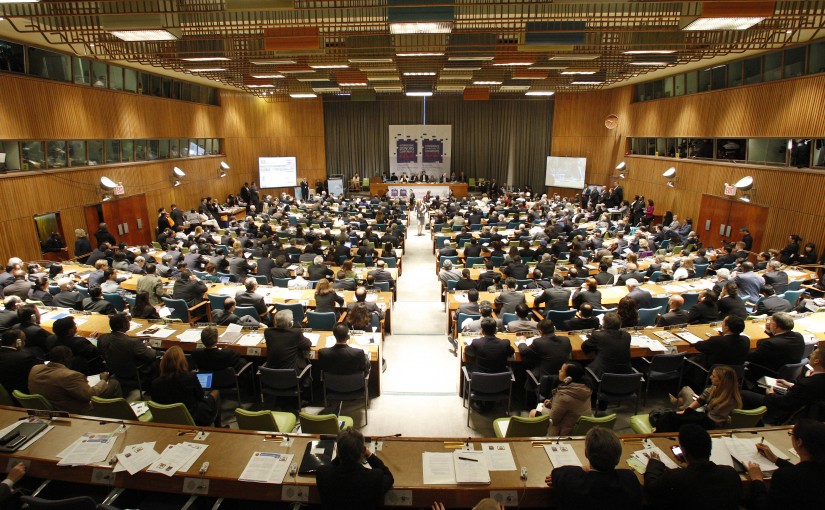This joint post with Rita Perakis first appeared on the CGD blog.
Has the aid industry introduced the reforms it agreed in 2005 to make aid more effective? No, according to the survey published last week by the OECD DAC. In this blog post we reflect on why this matters, and what it means for the forthcoming summit in Busan.
The development sector is in a mess. Developing countries have to deal with a large and growing number of partners, each with separate agendas, priorities, and requirements. Meetings, reports, milestones and systems multiply. Skilled staff are hired away from governments and from business to serve in local agency offices or NGOs. Funding is fragmented and unpredictable, which means that developing countries are often unable to bring together the scale of long-term, predictable finance needed to undertake significant institutional reform and service delivery. As just one example – in Vietnam, it took 18 months and the involvement of 150 government workers to purchase just five vehicles for a donor-funded project, because of differences in procurement policies among aid agencies.
None of this is news, nor is it disputed. The donor club of industrialised countries, the DAC, says:
“poor co-ordination and unpredictable aid waste funds that should be eradicating poverty in the world’s poorest countries.”
Six years ago developed and developing countries committed themselves to fixing these problems. The Paris Declaration on aid effectiveness set out five principles to make aid more effective, and a set of thirteen measurable targets which they aimed to reach by 2010.
Last Thursday, the Development Assistance Committee of the OCED (the DAC) published the results of the monitoring survey. The DAC is not known for hard-hitting criticism of its members. But even this mild-mannered organisation feels compelled to call the results ‘sobering’.
Of thirteen measured targets to improve the effectiveness of aid, just one has been met. What was this one milestone which donors were able to reach? They lived up to their commitment to talk more to each other (“Strengthen capacity by coordinated support”).
The DAC reports that the areas of progress have been largely on the part of developing countries. These include putting in place sound national development strategies and results frameworks, and improvements in public financial management systems. According to the report, the areas of little or no progress are overwhelmingly on the part of donors: aid is still not on recipient countries’ budgets, is no more predictable, and is becoming increasingly fragmented.
When developing countries fall short of targets set for them by donors, we say they are ‘off track’ and start to talk about cutting off their aid. What happens when donors fall short of targets they have set themselves?
The DAC points out that although the overall results are disappointing, some good progress has been made in some places. That’s true, and it is interesting that there is no obvious pattern. For example, though Tanzania is highly aid dependent, it appears to have been effective at imposing more discipline on donors. Some of the results suggest that the survey leaves too much room for interpretation: for example, Japan’s relatively strong performance against the Paris indicators is difficult to reconcile with perceptions on the ground.
The Paris indicators are not a direct measure of aid effectiveness. They are measures of progress towards goals which are thought by the Paris signatories to be associated with better aid. But that connection is tenuous: for example, though Tanzania has done well at pushing donors to comply with the Paris principles, nobody seems to think that aid in Tanzania now delivers more bang for the buck than aid elsewhere (rather the opposite, if anything).
It should be no surprise that progress towards the Paris principles has been slow. The aid system represents a compromise between the interests of donors and recipients, mediated by organisations and agencies with interests of their own. For example, donors have not been willing to make aid more predictable. That’s because there is political value to them in being able to dispense or withhold aid according to the latest fad or political pressure, and aid implementing agencies enjoy having the power of day-to-day control. Though retaining this discretion is estimated to reduce the overall value of aid by 15-20 percent, the political and institutional benefits to donors apparently outweigh the disadvantages of supplying less effective aid – perhaps because the people who suffer from ineffective aid don’t have votes in donor countries. Making an international commitment to fix this could help a little, because it adds very slightly to the political cost of lack of predictability. But the political cost of failing to meet this commitment is evidently too small to make a difference to the political calculation. That’s what we see in the monitoring survey: the proportion of aid that is classified as predictable has risen from 42% in 2005 to – drum roll – 43% in 2010: some way short of the target of 71% by 2010.
Can the forthcoming summit in Busan in November change this? It is hard to see how yet another conference with yet another communiqué will change these underlying political dynamics. The latest news is that Ban Ki Moon and Hillary Clinton are both planning to attend. Does the political weight of a communiqué increase in proportion to the size of the motorcades at the summit?
The political constraints which lead to ineffective aid are genuinely difficult to overcome. This should be ‘sobering’ to donors as a measure of their inability to fix long-standing and well-documented problems. But it should also be ‘sobering’ to those same donors who travel around the world pressing developing countries to implement reforms in the face of much more substantial political constraints. If donors cannot implement something as simple and uncontroversial as coordinated country missions or common procurement rules, why do they expect developing countries to be able to implement changes in land tenure or public enterprise reform?
We should give credit to the DAC for getting an agreement to reform, putting in place a monitoring system, recording the progress that has taken place, and stimulating the debate about aid effectiveness. But it is neither desirable nor sustainable that the donor club should be responsible for tracking the donors’ performance against their commitments. A more independent watchdog would surely have reported donors’ failure to meet 12 out of 13 targets with a greater sense of outrage.
Finally, all this is becoming increasingly anachronistic. The Paris principles are most obviously relevant to countries that are low income and stable. But there are now just thirteen of those: most of the world’s poor now live in middle income countries and fragile states. The DAC represents the donors who are members of the OECD, but does not include China and other emerging powers, foundations, private giving and NGOs, many of whom do not share the DAC’s view about what makes aid effective. The challenge for Busan is to define the role of aid in helping to build a sustainable, resilient and inclusive global economy.






6 responses to “What happens when donors fail to meet their commitments?”
I don’t understand this bit: the Paris principles are supposed to reduce the inefficiency in donor practises. If Tanzania has done well on that score, how can aid bang for buck not have risen if waste has fallen? Or, if waste hasn’t fallen, what do the Paris principles mean if complying with them does not reduce waste?
Luis –
I have a theory about this which is probably worthy of a whole blog post, but let me float it here and see how it fares.
I believe the Paris indicators are, for the most part, good indicators of the underlying health of the development system. If the system were working well, you’d expect to see donors using country systems, a better division of labour, a better focus on results, more predictable aid, and greater coordination.
But I think these are merely surface manifestations of the underlying health of the system. In a healthy aid system, donors would be focusing on the activities in which they had the biggest impact, coordinating with each other to the extent that the benefits of doing so outweighed the costs, using country systems where the long term benefits of doing so justified the risks, supporting the country’s own development plans because those are the investments most likely to bear fruit, and avoiding the waste of duplication and of spreading themselves too thin.
To be healthy in this sense, the aid system needs more transparency and accountability, incentives to overcome principal-agent problems, mechanisms to enable decentralised decision making by well-informed decision-makers. When those things are in place, the system will work better and one consequence will be an improvement against the Paris indicators.
My feeling is that focusing on the Paris principles to make the aid system work better is like trying to fiddle with the speedometer to make a car go faster. (Or, to use a different metaphor, like trying to cure a disease by treating the symptoms). The issues identified by the Paris Declaration are real and important, but they are the consequences not the causes of the underlying problems.
That’s why when a country like Tanzania forces donor to stick more closely the Paris principles, but without addressing the underlying problems, aid doesn’t get noticeably more effective. You end up with what Lant Pritchett calls ‘isomorphic mimicry’ – the result of which is “not functional organizations and institutions but mimics, which can adopt the camouflage of capable organizations without any of the associated drive for performance.”
Does any of that ring true to you?
Owen
Owen,
Well, it certainly makes sense; I can’t say it rings true from personal experience, because I don’t have any … but it fits with things I’ve read. I’ve read similar things – concerning the distinction between symptoms of healthy systems, and things you can fiddle with to achieve system health – when it comes to “ownership”. That is to say, everybody agrees it is a good idea, but attempts to achieve it can merely achieve the appearance of it, rather than the essence.
However, if by forcing donors to stick more closely to the Paris principles, and in doing so have eliminated some unhelpful bureaucratic overhead, I still don’t quite see how that cannot have raised efficiency (bang for buck). This reveals I don’t understand what the substance of Tanzania having forced donors to stick to Paris principles actually is. Have they elimated some duplication between donors, for instance? Or are donors just giving an appearance of having done so?
Might the impression that Tanzania has not increase bang for buck be explained by such a thing being hard to observe? Suppose, for example, you start with a system where each $10 of aid entails $2 of donor costs and $2 of recipient costs to administer, leaving $6 “net” aid, Then you shave $1 from donor and recipient costs and achieve $10 of gross aid translating into $8 net. Might it be the case that what people observe is the “bang for the buck” achieved with the ‘net’ aid dollars, whereas the ratio of gross aid to net aid is harder to observe? [I have pulled this idea out of my backside just now; for all I know it’s the efficacy of net aid that is impossible to observe, and ratio between gross aid, and aid net of overheads, is the easy bit].
[…] The OECD’s report this week documenting the almost complete failure of donors to make good on the promises of the Paris Declaration has indeed been “sobering.” Owen Barder lays out the significance of the report in a terrific blog on what happens when donors fail. […]
[…] more about my reading habits than anything else.) But when even the normally upbeat Owen Barder is moved to say “The development sector is in a mess.” I am inclined to think that almost anything is better […]
As usual, another interesting post.
The nub of this one is in the last paragraph. But missing is the fact that just as donors and recipients are not homogeneous – I am struck, in passing, how US centric many of the comment postings about the nature of aid and donors are – so recipient countries shouldn’t be conflates with their governments. Aid, no matter how “effective” can only do so much. The fact the Tanzanian government is helping to drive donor behaviour more in line with Paris principles, if that is the case, won’t mean that the domestic political and economic interests within the countrynwill work to the benefit of the poor and disadvantaged aid is (at least by some donors) intended to serve. I hasten to add I don’t know enough about Tanzania to judge if that is likely to be the case. Transparency is iis of course therefore important for accountability on many levels covering donors and recipients.
I’d also just note that discussions on aid are often around aid transfers. Yet aid is also about ideas. That may not be so relevant to this posting but it should not be forgotten when we think about the role of aid.